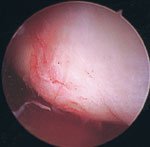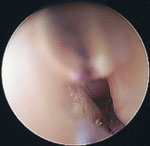Ligament injuries do not impact results of surgically treated distal radius fractures
According to the results of a recently presented study, concomitant wrist ligament injuries do not affect subjective and objective outcomes after surgically treated distal radius fractures.
“Ligament injuries in operatively treated distal radius fractures may not need to be addressed as they do not seem to affect outcomes,” Peter Tang, MD, MPH, said in his presentation at the 2011 Annual Meeting of the American Society for Hand Surgery in Las Vegas. “However, since we had a low incidence of severe injuries, it is unclear whether these severe injuries should be addressed. Surgeons should still exercise judgment on a case-by-case basis.”
For their study, Tang and colleagues hypothesized that scapholunate interosseous ligament (SLIL), triangular fibrocartilage complex (TFCC) and chondral surface injuries would affect both subjective and objective outcomes up to 1 year after fracture treatment.
Analysis of ligament injuries
Tang and colleagues conducted a prognostic, prospective evaluation of 42 patients who underwent open reduction and internal fixation (ORIF) for distal radius fractures, of which 30 were available for evaluation at 1 year. After radiographic evaluation, the team categorized the patients into one of the following four groups:
- patients with no injuries;
- patients with SLIL injuries;
- patients with TFCC injuries; and
- patients with combined injuries.
SLIL injuries were classified using: Grade 0 no injury; grade 1 - attenuation, no visible tear ± hemorrhage (Figure 1), grade 2 - partial tear showing no “drive through” sign; and grade 3 - complete tear showing a positive “drive through” sign .
|
|
|
Images: Tang P |
Outcome measures included the visual analog scale (VAS), DASH, grip and key pinch strength, and range of motion (ROM). The investigators used ANOVA analysis to evaluate correlations of outcome measures and controlled for chondral injuries and AO type.
No effect on outcomes
The researchers found 45% of patients with SLIL injuries, including 12 grade 1, four grade 2, and three grade 3. The researchers found that 50% of the patients had TFCC injuries with seven central, six peripheral and eight radial-sided injuries. They found 29% of patients had damage to articular cartilage. These results compared well to the incidence found on literature review conducted by the investigators: 44% SLIL injuries, 43% TFCC injuries and 13% chondral damage.
The team also found no significant differences among their four patient groups in terms of DASH and VAS scores, ROM, and grip and key pinch strength. In total, the investigators found a 71% incidence of ligament injuries among patients with distal radius fractures.
Limitations to the study, Tang said, included a small cohort of patients. Other limitations included a limited follow-up, a low incidence of severe injuries, variable arthroscopic technique, and variable treatment of ligament injuries. – by Renee Blisard
References:
- Tang P, Swart E, Ding A. Do wrist ligament injuries affect outcomes in operative distal radius fractures? Paper #45. Presented at the 2011 Annual Meeting of the American Association for Hand Surgery. Sept. 8-10. Las Vegas.

- Peter Tang, MD, MPH, can be reached at New York Presbyterian Hospital – Columbia University Medical Center 622 West 168th St, PH-11, New York, NY 10032; 212-305-0403; email: pt2214@columbia.edu.
- Disclosures: Tang has had previous research funding from the OREF and the AAHS, and current research funding from the ASSH.



